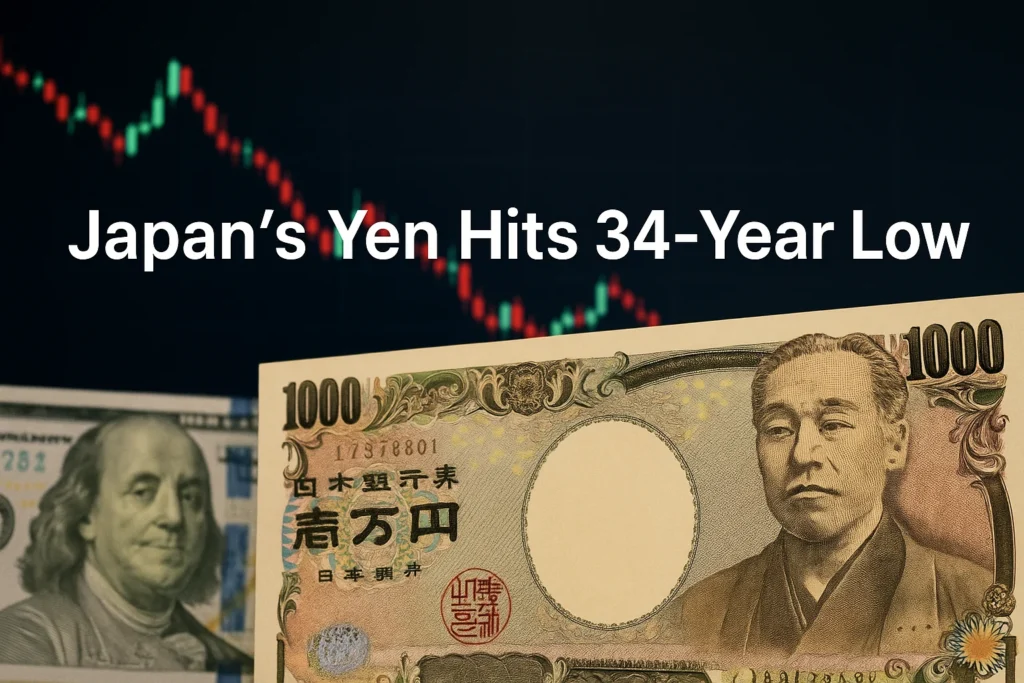Introduction: The Unraveling of a Financial Giant
The quiet stability that once defined Japan’s currency has been shattered. The Japanese yen, for decades a symbol of financial strength and a global safe haven, has embarked on a dramatic and historic plunge, reaching its lowest valuation against the US dollar in over 34 years. As the exchange rate breaches the critical 160-yen-to-the-dollar mark, a profound sense of uncertainty is gripping the nation and sending shockwaves through the global financial system. This isn’t merely a routine market fluctuation; it is a full-blown currency crisis that reflects deep-seated structural issues and a fundamental divergence in global economic policy. This article explores the intricate tapestry of historical context, root causes, immediate consequences, and potential future trajectories of this monumental event. The story of the yen’s collapse is a cautionary tale of a nation navigating a treacherous economic landscape, with implications that extend far beyond its borders.
A Historical Retrospective: The Yen’s Turbulent Journey
To fully grasp the gravity of the current situation, one must understand the yen’s storied past, a narrative marked by periods of immense strength and prolonged weakness.
The Rise and Fall of the Bubble Era
The yen’s modern story is often traced back to the Plaza Accord of 1985. In a coordinated effort by the world’s leading economies to address a soaring US trade deficit, the agreement was designed to depreciate the US dollar against the yen and other major currencies. This intervention sent the yen’s value soaring, reaching an astonishing peak of ¥80 to the dollar by 1995. This period of rapid appreciation fueled Japan’s asset bubble, where real estate and stock prices skyrocketed to unsustainable levels. When the bubble inevitably burst in the early 1990s, it ushered in a “Lost Decade” of deflation, stagnant growth, and financial turmoil that would last for nearly three decades. Throughout this period, the yen remained relatively stable, fluctuating between ¥100 and ¥125 to the dollar, occasionally acting as a safe-haven asset during moments of global financial panic.
The Abenomics Experiment and a New Strategy
In 2012, then-Prime Minister Shinzo Abe launched an ambitious economic strategy known as “Abenomics.” The program’s “three arrows”—bold monetary policy, flexible fiscal policy, and structural reforms—were designed to pull Japan out of its decades-long deflationary spiral. A cornerstone of this policy was the deliberate weakening of the yen to boost exports and corporate profits. From 2012 to 2015, the yen depreciated from ¥78 to a more export-friendly ¥125 against the dollar. While this strategy successfully boosted the earnings of Japan’s corporate giants and stock market, it failed to achieve its ultimate goal of creating sustainable inflation and robust wage growth, leaving the economy vulnerable to future shocks.
The Perfect Storm: Pandemic and Post-Pandemic Turmoil
The stage for the current crisis was set in the wake of the COVID-19 pandemic. As global supply chains unraveled and massive government spending flooded the world, inflation surged to levels not seen in decades. The subsequent monetary policy responses from central banks around the world, particularly the US Federal Reserve, created a perfect storm for the Japanese yen. The Fed’s aggressive interest rate hikes contrasted starkly with the Bank of Japan’s persistent commitment to its ultra-loose monetary policy, creating a chasm in interest rates that would become the primary engine of the yen’s historic collapse.
The Drivers of the Yen’s Collapse: A Convergence of Forces
The yen’s weakness is not a single issue but a complex interplay of monetary policy, structural economic challenges, and broader geopolitical forces.
The Great Monetary Policy Divergence
The most significant factor driving the yen’s devaluation is the profound and widening gap between US and Japanese interest rates. Since early 2022, the US Federal Reserve, in its determined battle against inflation, has embarked on one of the most aggressive rate-hiking cycles in its history, pushing its benchmark interest rate from near zero to a range of 5.25-5.50%. This “hawkish” stance has made dollar-denominated assets incredibly attractive to global investors, who can now earn significant returns on safe investments like US government bonds.
In contrast, the Bank of Japan has stubbornly maintained a “dovish” policy. Haunted by the fear of renewed deflation, the BOJ has kept its short-term interest rate in negative territory (-0.1%) and implemented a “yield curve control” policy to cap the yield on 10-year government bonds. This policy, designed to stimulate the domestic economy, has made yen-denominated assets far less appealing to investors. This stark monetary policy divergence has created a powerful incentive for a “carry trade,” where investors borrow in low-interest yen and invest in higher-yielding dollar assets, thereby selling the yen and driving its value down.
Japan’s Deep-Seated Structural Challenges
Beneath the surface of monetary policy, Japan is grappling with a series of long-standing structural issues that exacerbate the currency’s weakness:
- Demographic Decline: Japan faces a demographic time bomb with a rapidly aging and shrinking population. This not only puts immense pressure on social security systems but also leads to a decline in domestic demand and a shortage of skilled labor, hampering long-term economic growth.
- Productivity Stagnation: Despite being a technological leader, Japan’s productivity growth has been lackluster for decades, lagging behind other advanced economies. This lack of efficiency makes it harder for the nation to compete on a global scale.
- Energy and Resource Dependence: As a resource-poor island nation, Japan imports nearly 90% of its energy needs. The weak yen makes these critical imports—oil, natural gas, and coal—significantly more expensive, feeding into inflation and straining the nation’s trade balance.
Global Macroeconomic and Geopolitical Shifts
External forces have also played a crucial role in the yen’s freefall:
- US Economic Resilience: The surprising strength and resilience of the US economy, even in the face of aggressive rate hikes, have bolstered the dollar’s status as the world’s reserve currency and a safe haven, further intensifying its strength against the yen.
- China’s Slowdown: A slowdown in China, Japan’s largest trading partner, has weighed on Japanese exports, which are crucial for economic growth.
- Geopolitical Uncertainty: Ongoing geopolitical tensions, including the conflict in Ukraine and rivalry between the US and China, have driven investors toward the perceived safety of the US dollar, away from other major currencies.
The Domino Effect: A Society in Transition
The yen’s collapse is not an abstract financial event; its effects are rippling through every facet of Japanese society.
Households Under Immense Pressure
For ordinary Japanese citizens, the weak yen is a source of tangible financial pain. The cost of living is rising rapidly as prices for imported goods—from food and gasoline to everyday electronics—soar. A family’s monthly grocery bill is now significantly higher, and the dream of an overseas vacation, once a common luxury, has become prohibitively expensive. This erosion of purchasing power is particularly acute given that, for years, Japanese wages have remained stagnant. While nominal wages are finally beginning to tick up, they are not keeping pace with inflation, leading to a decline in real wages and a severe squeeze on household budgets.
A Tale of Two Corporate Worlds
The corporate sector in Japan is experiencing a sharp divide, creating clear winners and losers. The winners are Japan’s mighty exporters, such as automakers Toyota and Honda, and technology giants Sony and Panasonic. The weak yen makes their products cheaper and more competitive in international markets, leading to soaring profits. For these companies, a weak yen is a boon, a powerful tailwind for their global operations.
Conversely, domestic-focused companies and importers are facing an existential threat. Retailers, food processors, and energy firms are grappling with the rising costs of imported goods and fuel. This is eating into their profit margins and forcing them to pass on higher prices to consumers, further fueling inflation and straining their business models.
Strains on the Financial Sector
The yen’s volatility is also creating new challenges for Japan’s financial sector. Life insurers and pension funds, which hold vast portfolios of overseas investments, are seeing the yen value of those investments increase. However, the costs of currency hedging—a strategy to protect against exchange rate fluctuations—are also rising, eating into their overall returns. Regional banks, meanwhile, are struggling with narrow interest margins and the declining value of their Japanese government bond holdings.
The Government’s Response: Tools and Limitations
Japan’s Ministry of Finance and the Bank of Japan are now in a high-stakes game of economic management, with limited and often contradictory tools at their disposal.
Foreign Exchange Intervention: A Temporary Fix
The Ministry of Finance has intervened in the currency markets, spending billions of dollars to buy up yen and prop up its value. However, these interventions have proven to be a temporary solution, a stop-gap measure that fails to address the underlying cause of the yen’s weakness. The market is now so large and global that no single government can unilaterally counter a powerful macroeconomic trend for long. Repeated interventions also risk depleting Japan’s foreign currency reserves and drawing criticism from international partners.
The Bank of Japan’s Policy Dilemma
The BOJ is facing an impossible choice. A significant interest rate hike, while potentially stabilizing the yen, could also jeopardize the fragile economic recovery and trigger a recession. The specter of past deflationary periods makes the BOJ extremely cautious about tightening monetary policy too quickly. Any adjustments to its yield curve control policy, while a step toward normalization, have so far been too timid to have a lasting impact on the yen. The market is waiting for a bold move, but the BOJ is hesitant to make one, fearing the unintended consequences.
Fiscal Policy Constraints
Japan’s massive public debt, which stands at over 260% of GDP, severely limits the government’s ability to use fiscal policy to stimulate the economy. Any new stimulus measures risk further ballooning the debt and could potentially weaken the yen even more by signaling a lack of confidence in the economy’s ability to stand on its own.
Global Implications: A Global Ripple Effect
The yen’s crisis is not confined to Japan’s borders; it has significant international implications.
Spillovers in Asia
As a major regional economic player, Japan’s crisis is affecting its neighbors. The weak yen puts competitive pressure on exporters in countries like South Korea and Taiwan, whose currencies may also weaken in response. Changes in Japanese investment flows and trade patterns could disrupt regional supply chains and economic stability.
Consequences for Developed Markets
In the United States and Europe, the weak yen has a mixed impact. It makes Japanese imports cheaper, potentially benefiting consumers but also putting pressure on domestic producers. More broadly, the crisis tests the stability of the global financial system, as the unwinding of complex “carry trade” positions could trigger market volatility.
Future Scenarios: A Crossroads for Japan
The path forward is uncertain, with three potential scenarios emerging:
- The Optimistic Path: The Federal Reserve begins cutting rates as US inflation subsides, narrowing the interest rate gap. The BOJ, in turn, can gradually and carefully normalize its policy without causing a recession. This “soft landing” scenario would see the yen stabilize and Japan’s economy continue its slow recovery.
- The Pessimistic Path: The yen’s freefall accelerates, breaching key psychological levels and leading to a full-blown financial crisis. The BOJ is forced to undertake a rapid and aggressive tightening of monetary policy, which triggers a severe recession. This scenario could lead to widespread financial instability and a loss of global confidence in Japan’s economy.
- The Most Probable Path: A slow and volatile stabilization, with the yen fluctuating around the 150-160 level. The BOJ will likely make cautious, incremental changes to its policy, and the government will continue with limited interventions. This middle-of-the-road scenario suggests that Japan will continue to grapple with its structural challenges for the foreseeable future, without a clear-cut resolution to the currency crisis.
Conclusion: A Defining Moment for a Nation
The yen’s collapse is more than a financial event; it is a defining moment for Japan. It exposes the long-term consequences of a unique economic philosophy and a decade of deliberate policy choices. The decisions made in Tokyo in the coming months will not only determine the future of the yen but will also shape Japan’s economic trajectory for generations. As a global community, we are watching a pivotal drama unfold, one that serves as a stark reminder of the interconnectedness of our financial systems and the delicate balance required to maintain stability in an ever-changing world. The lessons learned from Japan’s crisis will undoubtedly inform policymakers worldwide as they navigate their own economies in an era of increasing fragmentation and geopolitical tension.




de1rpw